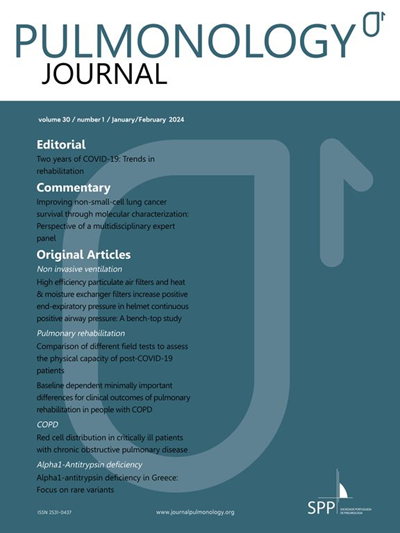甲基苯丙胺使用障碍患者肺动脉高压和肺部疾病的相关性和相对风险。
IF 10.4
2区 医学
Q1 RESPIRATORY SYSTEM
引用次数: 0
摘要
目的:甲基苯丙胺会对健康造成很大的短期和长期不利影响。我们的目的是在人群水平上评估吸食甲基苯丙胺对肺动脉高压和肺部疾病的影响:这项基于人群的回顾性研究使用了台湾国民健康保险研究数据库 2000 年至 2018 年间的数据,其中包括 18 118 名甲基苯丙胺使用障碍(MUD)患者和 90 590 名年龄和性别相同、无药物使用障碍的非暴露组匹配参与者。该研究采用条件逻辑回归模型来估算吸食甲基苯丙胺与肺动脉高压和肺部疾病(如肺脓肿、肺水肿、肺炎、肺气肿、胸膜炎、气胸或肺出血)之间的关系。使用负二项回归模型确定了甲基苯丙胺组和非甲基苯丙胺组之间肺动脉高压和肺部疾病住院的发病率比(IRRs):在8年的观察期内,32名(0.2%)甲基苯丙胺感染者和66名(0.1%)非甲基苯丙胺感染者患有肺动脉高压,2652名(14.6%)甲基苯丙胺感染者和6157名(6.8%)非甲基苯丙胺感染者患有肺部疾病。在对人口统计学特征和合并症进行调整后,MUD 患者罹患肺动脉高压的几率是非 MUD 患者的 1.78 倍(95% 置信区间 (CI) = 1.07-2.95),罹患肺部疾病的几率是非 MUD 患者的 1.98 倍(95% 置信区间 (CI) = 1.88-2.08),尤其是肺气肿、肺脓肿和肺炎的几率依次递增。此外,与非甲基苯丙胺组相比,甲基苯丙胺组因肺动脉高压和肺部疾病住院的风险更高。其内部相关系数分别为 2.79 和 1.67。与只吸食甲基苯丙胺的人相比,有多种物质使用障碍的人患肺水肿、肺脓肿和肺炎的风险更高,调整后的几率比分别为 2.96、2.21 和 1.67。然而,肺动脉高压和肺气肿在有或没有多种药物使用障碍的 MUD 患者之间没有显著差异:结论:MUD 患者罹患肺动脉高压和肺部疾病的风险较高。临床医生需要确保获得甲基苯丙胺接触史,作为这些肺部疾病检查的一部分,并对这一诱因进行及时处理。本文章由计算机程序翻译,如有差异,请以英文原文为准。
Associations and relative risks of pulmonary hypertension and lung diseases in individuals with methamphetamine use disorder
Objective
Methamphetamine causes considerable short- and long-term adverse health effects. Our aim was to assess the effects of methamphetamine use on pulmonary hypertension and lung diseases at the population level.
Methods
This population-based retrospective study used data from the Taiwan National Health Insurance Research Database between 2000 and 2018 that included 18,118 individuals with methamphetamine use disorder (MUD) and 90,590 matched participants of the same age and sex without substance use disorder as the non-exposed group. A conditional logistic regression model was used to estimate associations of methamphetamine use with pulmonary hypertension and lung diseases such as lung abscess, empyema, pneumonia, emphysema, pleurisy, pneumothorax, or pulmonary hemorrhage. Incidence rate ratios (IRRs) of pulmonary hypertension and hospitalization due to lung diseases were determined between the methamphetamine group and non-methamphetamine group using negative binomial regression models.
Results
During an 8-year observation period, 32 (0.2%) individuals with MUD and 66 (0.1%) non-methamphetamine participants suffered from pulmonary hypertension, and 2652 (14.6%) individuals with MUD and 6157 (6.8%) non-methamphetamine participants suffered from lung diseases. After adjusting for demographic characteristics and comorbidities, individuals with MUD were 1.78 times (95% confidence interval (CI) = 1.07–2.95) more likely to have pulmonary hypertension and 1.98 times (95% CI = 1.88–2.08) more likely to have a lung disease, especially emphysema, lung abscess, and pneumonia in descending order. Furthermore, compared to the non-methamphetamine group, the methamphetamine group was associated with higher risks of hospitalization caused by pulmonary hypertension and lung diseases. The respective IRRs were 2.79 and 1.67. Individuals with polysubstance use disorder were associated with higher risks of empyema, lung abscess, and pneumonia compared to individuals with MUD alone, with respective adjusted odds ratios of 2.96, 2.21, and 1.67. However, pulmonary hypertension and emphysema did not differ significantly between MUD individuals with or without polysubstance use disorder.
Conclusions
Individuals with MUD were associated with higher risks of pulmonary hypertension and lung diseases. Clinicians need to ensure that a methamphetamine exposure history is obtained as part of the workup for these pulmonary diseases and provide timely management for this contributing factor.
求助全文
通过发布文献求助,成功后即可免费获取论文全文。
去求助
来源期刊

Pulmonology
Medicine-Pulmonary and Respiratory Medicine
CiteScore
14.30
自引率
5.10%
发文量
159
审稿时长
19 days
期刊介绍:
Pulmonology (previously Revista Portuguesa de Pneumologia) is the official journal of the Portuguese Society of Pulmonology (Sociedade Portuguesa de Pneumologia/SPP). The journal publishes 6 issues per year and focuses on respiratory system diseases in adults and clinical research. It accepts various types of articles including peer-reviewed original articles, review articles, editorials, and opinion articles. The journal is published in English and is freely accessible through its website, as well as Medline and other databases. It is indexed in Science Citation Index Expanded, Journal of Citation Reports, Index Medicus/MEDLINE, Scopus, and EMBASE/Excerpta Medica.
 求助内容:
求助内容: 应助结果提醒方式:
应助结果提醒方式:


